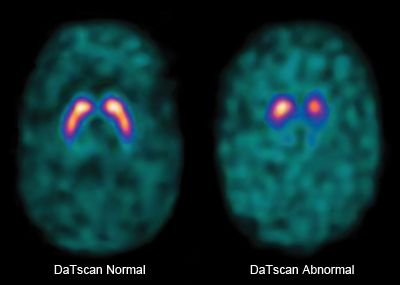Each year, approximately 60,000 new cases of Parkinson’s Disease (PD) are diagnosed in the United States. It is estimated that as many as one million people around the country suffer from the condition.
A timely and correct diagnosis can help patients and their families overcome the fears and frustrations associated with getting an accurate diagnosis so they can move on with their lives.
DaTscan™ is a radiopharmaceutical imaging agent that works by binding to dopamine transporters (DaT) in the brain. A specific marker for DaT, DaTscan produces images that provide visual evidence of the presence of dopamine transporters.
DaTscan, together with the DaTQUANT™ analytical tool, helps physicians evaluate neurodegenerative movement disorders, such as idiopathic (of unknown cause) PD. This agent may be used in conjunction with other diagnostic evaluations to help differentiate Essential Tremor (ET), which is an involuntary shaking of the hands, head and voice, from tremor due to Parkinsonian Syndromes (PS).
PS is a group of disorders (idiopathic Parkinson’s disease, multiple system atrophy and supranuclear palsy) that may occur when there is a reduction in the ability of dopamine, an essential chemical that works in the brain, to function normally.
DaTQUANT™ is an analytical tool that enhances the radiologist’s reading of each DaTscan study. This tool offers doctors a visual evaluation of the images acquired during the imaging exam, with this evaluation further assisting the detection of Parkinson’s disease. DaTQUANT has been proven to be a vital adjunct to DaTscan for accurately differentiating PD from essential tremors.
When would I get a DaTscan?
Your medical provider may recommend DaTscan with DaTQUANT to evaluate:
- shaking
- stiffness
- slowness of movement
- tremor
- difficulty with balance
- stiff facial expression
- shuffling walk
- muffled speech or soft voice
When symptoms of a movement disorder such as PS or ET appear, they may be mistaken for other conditions, especially in the elderly. You should talk to your doctor if you feel that you are experiencing any symptoms that you believe may be related to a movement disorder. The doctor will evaluate your symptoms and medical history and decide whether testing would be helpful.
It is important to note that symptoms may be different from patient to patient. Many patients experience some symptoms and not others. The progression of the disease, including how quickly or how slowly the disease worsens, may vary on an individual basis.

What Will I Experience?
You should not have a DaTscan if You are sensitive to iodine or any of the components of DaTscan. Your doctor can help you understand more about these ingredients.
Upon your arrival, you will be given medication to protect your thyroid gland. After about an hour, a technologist will insert an intravenous (IV) catheter into a vein in your hand or arm and administers the DaTscan imaging agent.
There is a three hour interval before the scan begins. You have the option to leave the facility and return in time for the test.
For the exam, you will lie on an examination table. When it is time for the imaging to begin, the camera or scanner will take a series of images. The camera may rotate around you or it may stay in one position and you may be asked to change positions in between images. While the camera is taking pictures, you will need to remain still for brief periods of time. In some cases, the camera may move very close to your body. This is necessary to obtain the best quality images. If you are claustrophobic, you should inform the technologist before your exam begins.
Typically, this scan takes approximately 45 minutes to complete.


